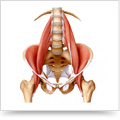The Mighty Psoas: What It Does, Why It Matters

While the psoas major muscle affects many fitness activities, there is widespread confusion about its actual role in the body. What does this muscle do, and why is it shortened in so many people?
Anatomy of the Psoas
While the psoas major may seem like one long muscle that passes over multiple joints, dissection reveals a slightly different story. The body of each psoas contains (on average) 11 branches of muscle fibers—fascicles with separate attachments to bony sites—with the most superior fascicle attaching to the lowest thoracic vertebra, while others continue on down to various sites on the lumbar spine and to a final attachment on the femur. In addition to attaching on the transverse processes of some vertebrae, the psoas attaches directly to each of the lumbar spine’s intervertebral disks. This adds up to a total of 22 attachments: one on each thigh and 20 points of attachment on the spine.
The psoas has two layers—superficial and deep. Embedded between these muscles is the lumbar plexus, a dense collection of nerves that innervate the transverse and oblique abdominals, the pelvic floor, the deep hip rotators and most thigh muscles (Kirchmair et al. 2008). Because the psoas attaches at multiple locations, passes over multiple joints and entraps a major neurological network, it is no wonder that so many injuries can be blamed on one misbehaving muscle.
Psoas Mechanics
In light of all those connection points, you might ask, Does the psoas move the spine? Does it flex the hip? Or does it do a little of both?
Biomechanists are always trying to figure out what a muscle is “supposed” to be doing, considering joint health, leverage and force production. All those connections to the spine seem to imply that the preferred role of the psoas would be to somehow move the spine. But tests of this hypothesis show that the angles of attachment don’t allow much force production during side bending (lateral flexion). During motions like sit-ups, the psoas simultaneously extends the upper vertebrae while flexing the lower vertebrae, creating a shearing motion on the spine—not the most preferred movement for long-term spinal health.
Studies show that the psoas has an active role in hip flexion, but compared with the iliacus, the psoas plays a larger role in stabilizing the vertebrae (keeping them from rotating in the frontal plane) than in generating leg motions (Hu et al. 2011). And finally, the many attachments make it extremely important that the psoas can lengthen enough to allow the spine, pelvis and hips to articulate and move naturally for a pain-free and injury-free body.
The “Sitting” Psoas
If you’ve ever watched a triathlete transition (decrepitly) from the cycling phase of a race to the running portion, you have a sense of how a long bout with a tightening psoas can affect our ability to walk upright. In a slightly less extreme way, hours (and hours and hours) in the sitting position affect the psoas’s ability to extend to its full length—a length that allows us to stand in alignment and, perhaps more crucially, allows for hip extension as we walk. If you quickly calculate how many of your clients move from 8 or more hours of sitting at their jobs to “fitness” activities that further perpetuate the skeletal arrangement of a shortened psoas (cycling, stair-stepping, sitting on weight machines), then it is no surprise that the exercising population has so many psoas-related issues of the low back, pelvis and hips.
What Does a Short Psoas “Look” Like?
It is not uncommon for professionals to spot an exaggerated curve in the “low back” and conclude that the client has an anterior pelvic tilt. This form of postural assessment is flawed, however, because there are no objective data points to determine actual skeletal position or where, specifically, the curve is occurring. The spinal curve from a tight psoas is not a hyperextension of the lumbar spine, nor does it result from an anterior pelvic tilt. It is, rather, a unique curve created by anterior displacement (shear) of superior vertebrae coupled with various degrees of extension and flexion in the upper and lower lumbar spine, respectively. It looks very similar to hyperlordosis, with the exception of one bony marker: the rib cage.
For a reference list, plus information on how to assess a shortened psoas in your clients and what exercises can lengthen the muscle, please see “Can This Psoas Be Saved?” in the online IDEA Library or in the October 2012 issue of IDEA Fitness Journal.




